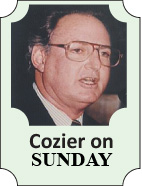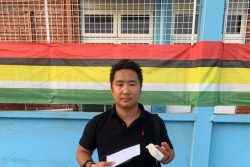They offered opportunities for Keiran Powell to entrench himself as the West Indies opening batsman as his palpable potential indicates that he should be.
Instead, the tall left-hander from Nevis couldn’t wait for the ill-starred tours of India and New Zealand to be over. It was a mood brought on by a combination of his long absence from his idyllic island, the constant intensity of the cricket, his own disappointing form, the lack of unity within the team, identified by ODI captain Dwayne Bravo, and, not least, the repeatedly heavy defeats.
“This week will probably be the most difficult week of my life for sure, having been away from home for longer than anyone else on this tour,” Powell said one match and a few days away from last Thursday’s departure from New Zealand.
 “It takes a toll on anyone to be away from home for such a long time.”
“It takes a toll on anyone to be away from home for such a long time.”
It is a problem that confronts all teams for basically similar reasons. England are encountering it now in Australia. It presents administrators everywhere with the challenge of how to limit the likely physical and mental strain protracted tours place on players.
In light of England’s 5-0 thrashing in the Ashes, Geoffrey Boycott’s typically radical solution would be to preclude those identified as the nucleus of the Test team from ODIs and T20s during the coming home series against Sri Lanka and India.
It is a hardly feasible plan; the West Indies, for one, couldn’t block their players from going off to lucrative franchise T20 leagues, even if Clive Lloyd did charge that they looked “drunk on T20” in their innings defeats in the two Tendulkar Farewell Tests in India.
Still, it is an issue worth discussion between the West Indies Cricket Board (WICB) and the West Indies Players Association (WIPA).
Powell, Narsingh Deonarine and Chadwick Walton were the only three of the 26 players chosen for the five Tests, eight ODIs and two T20s in India and New Zealand who were also engaged in the preceding ‘A’ team series in India.
But for a couple of days between the end of the ‘A’ team’s campaign and joining the preparation camps in Barbados and Florida for the return to India, they were on West Indies duty of one kind or another between September 11 and January 16.
Like Powell, Deonarine didn’t use his chance – probably his last – to nail down a place in the senior team; Walton had to wait until the final fortnight before he was even included in the starting 11 for three ODIs and the two T20s in New Zealand.
All told, they were on the other side of the planet for 113 days; they were located in 18 cities (10 in India, eight in New Zealand) as different from each other as hot, crowded Kanpur was from grey, chilly Queenstown.
Denesh Ramdin was the only other survivor to come through the two major tours unscathed – and with reputation enhanced. Injuries, a bowling suspension and mystifying “personal reasons” eliminated six key men along the way.
Such extended tours are now rare; they are not new.
Tours of England routinely went throughout the four months of summer; the Ashes still do. Five Tests were the norm. Those elsewhere were not significantly shorter.
The West Indies set out by ship for their initial visit to Australia in 1930-31 via the Panama Canal and New Zealand, spending three and a half months before sailing back to the Caribbean.
The double-tours of Australia and New Zealand in 1968-69 lasted from October 18 to March 23, all told 156 days covering 16 towns and cities in Australia, six in New Zealand.
Six years later, Clive Lloyd’s first assignment as captain was to India, Sri Lanka and Pakistan – just over four months from November 4 through to March 6. It took in 17 towns and cities in the three countries.
Such itineraries have been appreciably downsized. Only the Ashes are still guaranteed five Tests. Now two Tests can constitute a series, making way for the popular, abbreviated, money-making one-day formats.
The effect has been to amplify the pressure on Powell and those of his generation.
Until recently as 2000, Tests – and, latterly, ODIs – were interspersed with more relaxing encounters against state and country teams (in Australia), counties (in England) and zone combinations (in India). They offered possibilities to find form for those who needed to; those who were key players in the Test 11 could take a break.
It was also a time for those in the reserves to get some meaningful cricket and press their claims for promotion.
Through to the 1990s, there was a rest day during Test matches – and it was just that. Individuals chosing their ways to relax, playing golf, heading for the beach, just staying in.
Clyde Butts, the present chairman of selectors, even got married on the rest day of his debut Test against New Zealand in Georgetown in 1985. All that has now gone.
In both India and New Zealand, there was a solitary, three day warm-up match before heading into the incessant grind of Tests, ODIs and T20s.
The days between them were occupied either in training or travelling from venue to venue. In the most recent case, the West Indies’ journey from India to New Zealand lasted 30 hours; mercifully, coach Ottis Gibson allowed off-days towards the end in New Zealand.
The technological advances that put international communication at the players’ finger tips through direct dialing, Skype and the like are clearly a bonus not previously available. How much they compensate for the problems that faced the West Indies these past few months is questionable.
My first realization of the effects of a long and unrewarding tour on team and players was in New Zealand on the 1968-69 double tour down under, my first there on radio and newspaper assignment.
The West Indies arrived from across the Tasman with a 3-1 loss to Australia in the Tests. Even before a match was played, there was a knock on my tour; it was Rohan Kanhai reporting that he was leaving the tour and would not be available for the trip to England a couple of months later.
Instead, he played for his English county, Warwickshire. He returned to the West Indies’ fold the following year; by 1973, he was captain.
Within t a few days, the knock was from Seymour Nurse. He would be retiring after the third and final Test. He gave no reason and manager Berkeley Gaskin tried to talk him out of it. Seymour stuck to his word; his last Test innings was a little matter of 258.
Some years later, Nurse explained his decision to me.
“I found the players were not happy, we’d been playing too long,” he said. “When I’m playing the game, I don’t like to have any problems. I respect what the authorities say…and I found it was getting out of hand.
“It was the best thing for me to do was to call it a day,” he said. And he did.
West Indies cricket cannot afford any more Nurses.








